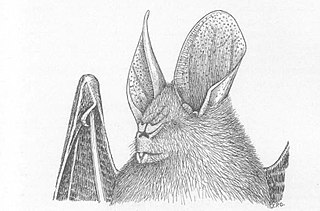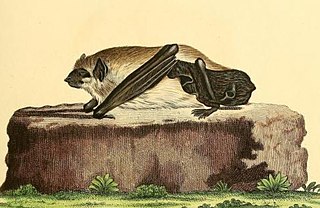
Nycteris comprises a genus of bats commonly called slit-faced or hollow-faced bats. They are grouped in the family Nycteridae. The bats are found in East Malaysia, Indonesia, and many parts of Africa.

Bate's slit-faced bat is a species of slit-faced bat frequently confused with Nycteris major. It is broadly distributed and common, living throughout many parts of Africa in forests and savannas.

The Ja slit-faced bat is a species of slit-faced bat that lives in the tropical and subtropical forests of Africa. Its habitat is fragmented and declining, and the species is therefore very rare. Logging and farming are currently the greatest threats to its habitat. The two known subspecies are N. m. avakubia and N. m. major.
Andersen's slit-faced bat is a slit-faced bat species found in East Africa. It has been recorded in Somaliland, through South Sudan and Ethiopia, into Kenya and Tanzania. No information is available on the population size of this species, which inhabits savanna habitats and semidesert.

The large slit-faced bat is a species of slit-faced bat with a broad distribution in forest and savanna habitats in West, Central, and East Africa. N. marica, is the available name for the southern savanna species if it is recognized as distinct from this species.

The hairy slit-faced bat is a species of slit-faced bat widely distributed throughout forests and savannas in Africa. Two recognized subspecies exist: N. h. hispida and N. h. pallida. Various forest populations in western and central Africa may represent separate species, although this had not been confirmed as of 2007.
The intermediate slit-faced bat is a species of slit-faced bat living in forest and savanna regions of west and central Africa. It is easily confused with Nycteris arge and Nycteris nana. It is broadly distributed, but is classified as near-threatened because of the threat of predicted habitat loss. It is much more restricted to true rainforest than is N. arge.

The large-eared slit-faced bat, is a species of slit-faced bat which lives in forests and savannas throughout Africa. Nycteris vinsoni was once considered a synonym of N. macrotis, but it became recognized as a separate species in 2004. Some, however, still consider N. vinsoni to be a subspecies of N. macrotis, and consider N. macrotis a species complex.

The Egyptian slit-faced bat is a species of slit-faced bat broadly distributed throughout Africa and the Middle East. It is a species of microbat in the family Nycteridae. Six subspecies are known.

Wood's slit-faced bat is a species of slit-faced bat that lives in the dry savanna regions of Southern Africa. Its numbers are declining due to habitat loss from logging and farming, pesticide use, and the decline of baobab trees on which these bats depend for roost sites.
Parissi's slit-faced bat is a species of slit-faced bat that may live in dry savanna regions of East Africa, near the Duba Valley and Benue River along with large rivers. It is only known from three specimens. One was found in northern Cameroon, one from southern Ethiopia, and the third from southern Somalia. Another possible specimen was found in West Africa, but it may be a member of a separate species, N. benuensis.

Schreber's yellow bat or the giant house bat, is a species of vesper bat. It is found in Benin, Democratic Republic of the Congo, Ivory Coast, Ghana, Kenya, Malawi, Mozambique, Nigeria, Senegal, Tanzania, Togo, and Zimbabwe. Its natural habitats are subtropical or tropical moist lowland forests, dry savanna, and moist savanna. It is an uncommon species and its biology is poorly known. It was first described in 1774 by the German naturalist Johann Christian Daniel von Schreber, who named it Vespertilio nigrita. It was later transferred to the genus Scotophilus, making it Scotophilus nigrita.

The lesser Angolan epauletted fruit bat is a species of megabat in the family Pteropodidae. It is found in Angola and the Republic of the Congo. Its natural habitats are subtropical or tropical dry and moist lowland forest, and savanna.

Noack's roundleaf bat is a species of bat in the family Hipposideridae. It is found throughout tropical Africa. Its natural habitats are subtropical or tropical moist lowland forests, moist savanna, caves, and subterranean habitats.

Veldkamp's dwarf epauletted fruit bat is a species of bat in the family Pteropodidae. It is the only species within the genus Nanonycteris. It is found in Benin, Cameroon, Central African Republic, Ivory Coast, Ghana, Guinea, Liberia, Nigeria, Sierra Leone, and Togo. Its natural habitats are subtropical or tropical moist, mangrove and montane forests, and savanna.
The Gambian slit-faced bat is a species of bat in the family Nycteridae found in Benin, Burkina Faso, Cameroon, Ivory Coast, Gambia, Ghana, Guinea, Guinea-Bissau, Mali, Mauritania, Niger, Nigeria, Senegal, Sierra Leone, and Togo. Its natural habitats are subtropical or tropical moist lowland forest and savanna.

The halcyon horseshoe bat is a species of bat in the family Rhinolophidae. It is found in Cameroon, Republic of the Congo, Democratic Republic of the Congo, Ivory Coast, Equatorial Guinea, Ghana, Guinea, Kenya, Liberia, Nigeria, Senegal, South Sudan, Togo, Uganda, possibly Gabon, and possibly Sierra Leone. Its natural habitats are subtropical or tropical dry forest, subtropical or tropical moist lowland forest, moist savanna, caves, and subterranean habitats. It is threatened by habitat loss.

The eloquent horseshoe bat is a species of bat in the family Rhinolophidae. It is found in Ethiopia, Kenya, Rwanda, Somalia, South Sudan, Tanzania, and Uganda. Its natural habitats are subtropical or tropical moist lowland forests, dry savanna, moist savanna, and caves. It is threatened by habitat loss.

The Guianan moist forests (NT0125) is an ecoregion in the east of Venezuela, north of Brazil and the Guyanas. It is in the Amazon biome. The climate is hot and humid, with two rainy seasons each year. As of 1996 the tropical rainforest habitat was relatively intact, although there were mounting threats from illegal logging and gold mining.














